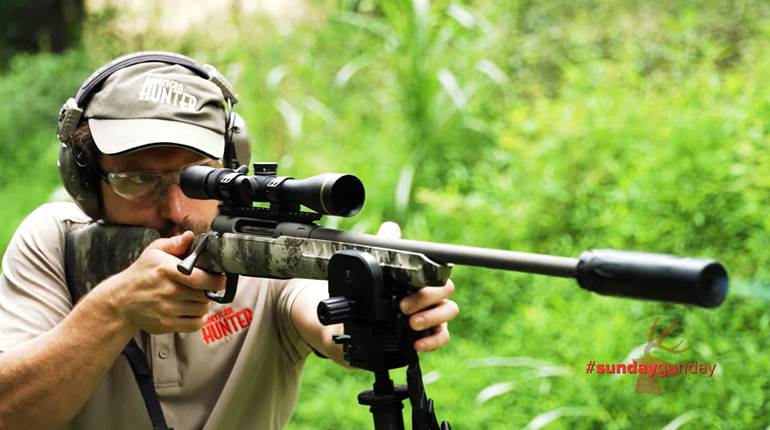
Weatherby Eyebrow—Noun: The rapid acceleration of the rear of the ocular housing of an optical device impacting the epidermal and subcutaneous tissue on the upper anterior cranium.
Alternate Names: Scope Eye, Scope Rash. Tasco Tap, Zeiss Zinger.
With apologies to Ed Weatherby—one of the finest, most genuinely nice men I believe I’ve ever met—we have been seeing an unusual number of cases of Weatherby eyebrow around the offices.
The craze toward modern magnums with cavernous powder capacitiesstarted with Ed’s father—the legendary Roy Weatherby. Speed, power and shock were the watchwords of the late Roy Weatherby. These loads hit hard on both ends; something about every action having an equal and opposite reaction. It’s not that Weatherby cartridges kick any harder than newer magnums of similar case capacity and bullet weight, they were merely first. And for its day, the .300 Wby. Mag. was—and remains—one of the finest big-game cartridges ever offered. My personal favorite is the .257 Wby. Mag.
The emergence of long ocular housings on variable-power scopes mounted above hard-kicking rifles has contributed to the scope-eye epidemic. One of the reasons Leupolds (OK, quality and value had something to do with it, too) became so popular is you generally were provided with an extra half-inch or so of eye relief. I'm not giving anything away here; other makers have caught on as they apparently have complex optical equipment—or rulers—for obtaining such measurements. Swarovski even adds a helpful rubber-coated rear ocular housing with a spring to soften the blow. Clever folks, those Austrians.
Shooting prone and crawling the stock can also lead to the condition. Having a rifle with a short length-of-pull doesn’t help, either. The key to avoiding this condition is to make sure your rifle fits and to mount the scope as far forward with the rings as possible while still being able to clearly view your reticle. It doesn’t matter on a .22, but is an important consideration on a .460 Wby. Mag., sorry Ed. Bottom line, if you hunt enough, odds are it will happen to you.
I have avoided serious laceration, knock on wood, although my colleague Aaron Carter has visibly developed scar tissue. Either that or he has taken up amateur boxing on nights and weekends and can’t stop a jab aimed at his right eye. In the interest of full disclosure, I haven’t bled, but I have broken bridges and nosepieces of eyeglasses or shooting glasses and experienced some swelling.
Sometimes, however, justice is served by the administration of ocular-housing induced pain. An unnamed firearm industry personage, who to be frank ranged from grating to exceedingly obnoxious, had been making a nuisance of himself to both his guide and his cameraman on a week-long hunt for a deliberately non-disclosed television show. Brash, arrogant, self-absorbed, yet whiney, are characteristics that sum up of the high points of this individual’s character. After a long hunt, with much carping, blame-shifting, antagonism and belittling of his companions, he finally had a shot at trophy bull from below it down a steep ridge from the prone position.
You can see where this heading. Despite serious personality issues this individual was a decent field marksman. He lined up the crosshairs, and executed a fine shot dropping the trophy bull. There were high fives all around the celebration of a successful hunt, but it was tempered by blood running down the happy hunter’s face with visible swelling from where the scope cracked him. But it wasn’t over.
“Time for the recreate,” said the cameraman with a barely-concealed knowing grin.
If you watch enough hunting shows, you will see the “recreate.” This is when the camera is placed in front, beside or above the hunter and his guide catching every whisper, most of which involve saying, “There he is. He’s a big one. Take him.” This is followed by a shot. Obviously, the cameraman and his tripod are between the quarry and the hunter—or at least conspicuous to said soon-to-be-harvested game animal—so it is indeed, after the fact. Editors and producers of outdoor television love this footage as it allows a separate camera view and often the opportunity to use dramatic music to build suspense. This is why it is called the recreate.
So this individual was forced to get back down into the prone, in the same place he had fired from. “No, you need to get closer to the scope,” coaxed the much maligned cameraman. “Lower, lower, closer—this needs to be believable. No, closer, get your head down. Okay hold it,” he cooed. What a beautiful shot. Okay fire one.”
Blam. Socko. Blood spatter. Growing contusion.
“Here’s a rag, wipe the blood off. Okay, I need to get it from the other angle, let me reset the camera,” as the camera captured a moment worthy of Peckenpah’s goriest cinema footage. “Alright let me get the other angle, I only need you to fire two more shots ... ”
The Weatherby eyebrow administering justice, one recreate at a time.





































